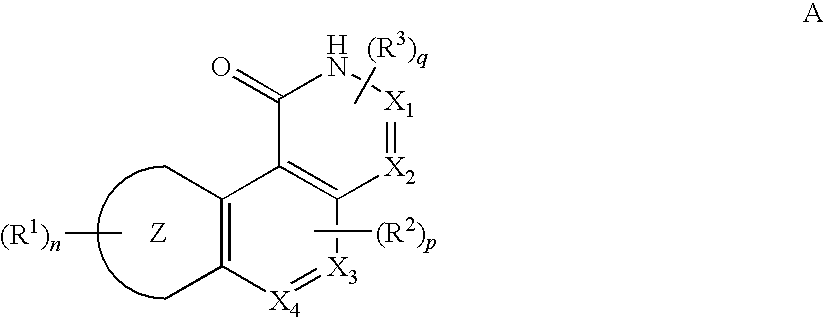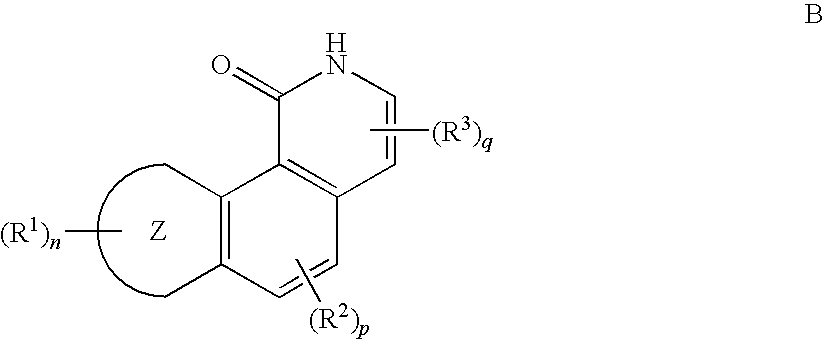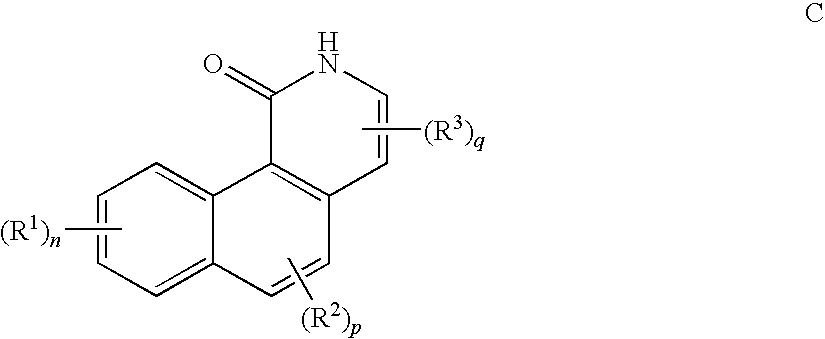Inhibitors of Checkpoint Kinases
a checkpoint kinase and inhibitor technology, applied in the direction of heterocyclic compound active ingredients, biocide, drug compositions, etc., can solve the problems of tumor cell death and significant limitation in the treatment of cancer resistance to these agents, and achieve the effect of inhibiting chk1 activity
- Summary
- Abstract
- Description
- Claims
- Application Information
AI Technical Summary
Benefits of technology
Problems solved by technology
Method used
Image
Examples
examples
[0652]Examples provided are intended to assist in a further understanding of the invention. Particular materials employed, species and conditions are intended to be further illustrative of the invention and not limitative of the reasonable scope thereof. The reagents utilized in synthesizing the compounds depicted in the following Tables are either commercially available or are readily prepared by one of ordinary skill in the art.
9-chloro-4-(1H-pyrazol-4-yl)benzo[h]isoquinolin-1(2H)-one (1-8)
3-(5-chloro-2-formylphenyl)isonicotinaldehyde (1-3)
[0653]Boronic acid (1-1, 2.0 g, 10.84 mmol), 3-bromo-4-pyridinecarboxaldehyde (2.01 g, 10.84 mmol), Na2CO3 (2M in H2O, 10.84 mL, 21.7 mmol) and Pd(PPh3)4 (0.62 g, 0.54 mmol) were suspended in dioxane (30 mL) and heated to reflux for 2 h. Upon completion, the reaction was diluted with H2O (100 mL) and extracted with EtOAc (3×50 mL). The organic layers were combined, dried over MgSO4 and filtered. The solution was concentrated under reduced pressu...
examples 1-8
[0744]Examples are provided below to further illustrate different features and advantages of the present invention. The examples also illustrate useful methodology for practicing the invention. These examples do not limit the claimed invention.
example 1
Identification of CHK1sv1 Using Real-Time PCR
[0745]To facilitate the determination of compound inhibitory properties, it is desirable to identify variants of the “normal” splicing of exon regions encoding CHK1. In particular, naturally occurring splicing variations resulting in the loss of the C-terminal regulatory domain of CHK1 were sought. Deletion of the C-terminus confers greater kinase activity to CHK1 (Chen et al., 2000, Cell 100:681-692; Katsuragi and Sagata, 2004, Mol. Biol. Cell. 15:1680-1689). Exons 2-8 encode the catalytic kinase domain and exon 9 encodes the linker region. The SQ and C-terminal regulatory domains lie within exons 10-13 (Sanchez et al., 1997, 277:1497-1501; Katsuragi and Sagata, 2004, Mol. Biol. Cell. 15:1680-1689). Real-time PCR experiments and RT-PCR have been used to identify and confirm the presence of novel splice variants of human CHK1 mRNA. A naturally occurring splice variant which encodes a C-terminal truncation of the CHK1 inhibitory domain was...
PUM
| Property | Measurement | Unit |
|---|---|---|
| pressure | aaaaa | aaaaa |
| temperature | aaaaa | aaaaa |
| temperature | aaaaa | aaaaa |
Abstract
Description
Claims
Application Information
 Login to View More
Login to View More - R&D
- Intellectual Property
- Life Sciences
- Materials
- Tech Scout
- Unparalleled Data Quality
- Higher Quality Content
- 60% Fewer Hallucinations
Browse by: Latest US Patents, China's latest patents, Technical Efficacy Thesaurus, Application Domain, Technology Topic, Popular Technical Reports.
© 2025 PatSnap. All rights reserved.Legal|Privacy policy|Modern Slavery Act Transparency Statement|Sitemap|About US| Contact US: help@patsnap.com



